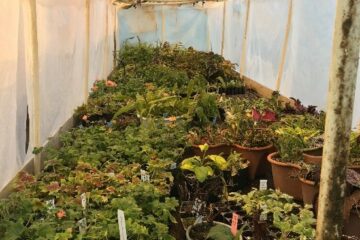Part 2: A Visit to the Agriculture Greenhouses
This is the second post of a series of #LabToField blogs that will explain the yearly cycle of variety development. Click here to read Part 1: Phytotrons.
U of S Celebrating Hort Week: May 4 to 12, 2019
“Connect with like-minded gardeners and pick up some new tips on how to keep your garden healthy and your yard beautiful. Hort Week offers the public engaging, accurate classes taught by enthusiastic garden professionals and they are suitable for new or experienced gardeners. Workshops may be taken for personal interest or for credit towards the Master Gardener Certificate Program.”
Agriculture Greenhouses
Hidden on the University of Saskatchewan’s campus located just north of the Canadian Light Source facility lie the Agriculture Greenhouses. On campus, the greenhouses are an important part of the variety development process, facilitating breeding and research work year-round. The Agriculture Greenhouses, built in 1992, have been upgraded and expanded to include two larger glass greenhouses, bringing the total number to thirteen, plus one poly greenhouse.
Each of these separate greenhouses can be controlled for light, temperature, and humidity, among other methods and tools that can be employed to ensure the health of plants and the validity of the research being conducted. Tools such as night shades can be drawn depending on daylight requirements and can be automatically set to close and open at the times required for each variety. Another unique set of tools at the greenhouse is the propagation benches. These benches are covered in canvas and include overhead misters to ensure the plants receive consistent, adequate moisture for their survival.
The greenhouses on campus are often used as teaching tools for the undergraduate and graduate programs offered through the College of Agriculture and Bioresources. They also house and grow the plant materials for the Agriculture building’s atrium, education and extension events, and materials for the U of S Horticulture Club meetings. More importantly, the greenhouses are used for plant research and development, with a specific emphasis on plant breeding.
Breeding Programs in the Agriculture Greenhouses

There are over 20 breeding programs using the campus greenhouses to facilitate their crop variety development. The greenhouses allow for crop breeding throughout the year, providing the opportunity for 3 full growth cycles to be conducted. This offers plant breeders the opportunity to conduct conventional crop breeding programs in the greenhouses no matter what the unpredictable Saskatchewan weather is doing outside.
The Agricultural Greenhouses are also home to the U of S fruit breeding program led by head researcher Dr. Bob Bors. In this program, significant developments have been made for sour cherry and haskap varieties. Breeding work is also conducted for apples, pears, hazlenuts, and other fruits. The success of the breeding program is a result of excellent varieties and unique funding, as 65% of royalty funds go directly back into the breeding program and the remaining 35% are used to purchase equipment and materials. Such a funding model ensures the breeding program maintains the capacity to further their research.
Pest Control in the Agriculture Greenhouses
As you might imagine, pest control is also an important part of greenhouse maintenance. In the past, spray applications and fumigation practices were used intensively to control insect populations. However, in recent years, pest control has shifted to an integrated management approach. Beneficial insects, including small wasps and mites, are introduced to chambers in the greenhouse to control populations of unwelcome, harmful insects such as thrips. Light chemical spraying is also conducted as required. At the end of each plant cycle, each greenhouse is emptied and cleaned to rid the facility of any remaining pests before the new cycle begins. This integrated pest management approach has been quite effective and pest levels remain minimal at the Agriculture Greenhouses.

What is a Poly Greenhouse?
The poly greenhouse added in 2001 is covered with a thick, sturdy plastic instead of the traditional glass. For at home gardeners and farmers, setting up a greenhouse using a polycarbonate covering could be less costly, depending on the quality of material chosen. Polycarbonate greenhouses actually retain heat better than traditional glass due to the internal buffer space between the double wall construction of the polycarbonate sheets. Unlike the glass greenhouses, the poly greenhouse at the U of S is not equipped with air conditioning. This makes it the warmest of the greenhouses in the summer heat, perfect to host tropical plants, ornamental flowers, and vegetables which can tolerate, and even thrive in, warmer temperatures.
How do Agriculture Greenhouses Provide Benefits to Farmers?
The agriculture greenhouses provide breeders the opportunity to run 3 plant cycles inside the greenhouse and an additional plant cycle in the field, totalling four full growing cycles in one year. This means that new varieties can be bred and developed potentially four times faster than if breeders only had the ability to grow out one generation of crosses per year outdoors. As a result, plant breeders are able to constantly look for new varieties with improvements over the current varieties available to farmers. The breeding and research work conducted at the U of S Agriculture Greenhouses is just one of many moving parts in the process of getting a new crop variety developed and ready for commercial use on farms in Canada.





do you have othere reference?
This blog was written thanks to the knowledge and insight provided by Dr. Bob Bor’s and Jackie Bantle of the Univesity of Saskatchewan Greenhouses. While typically we would love to provide more references, this bog was thanks to conversations Chelsea had with our local experts and doesn’t offer for more references. If you would like more information on a specific item, please let us know and we can try ad help you find that information!